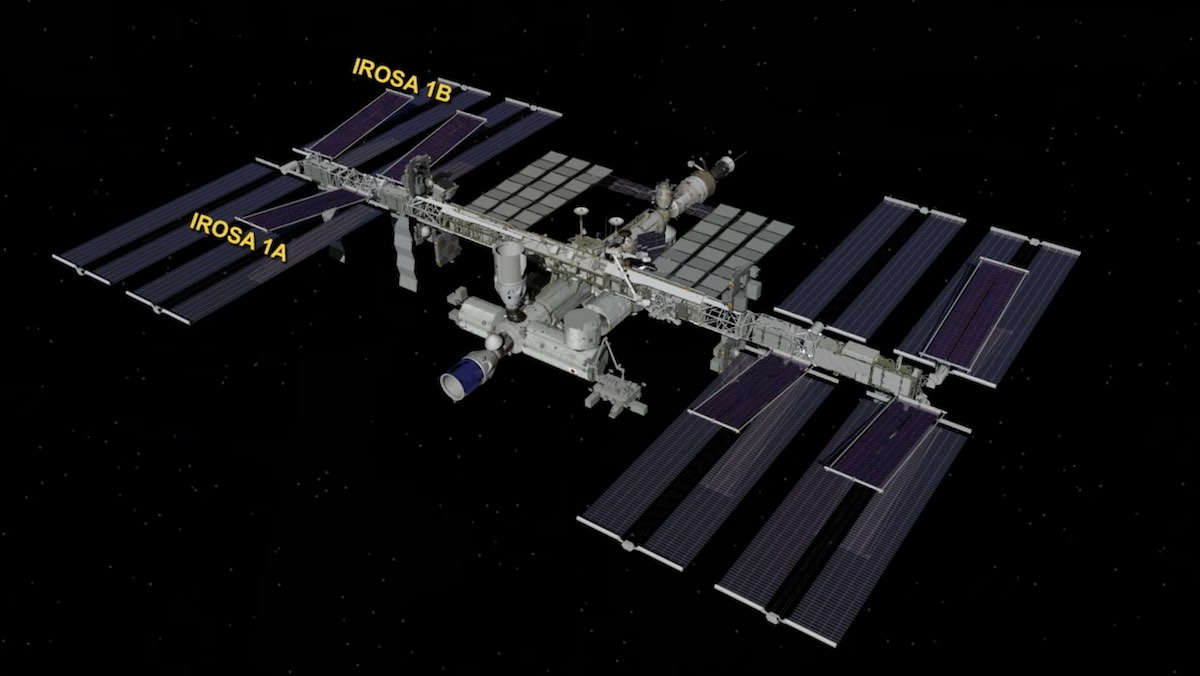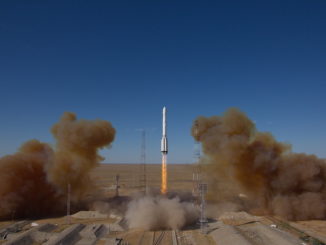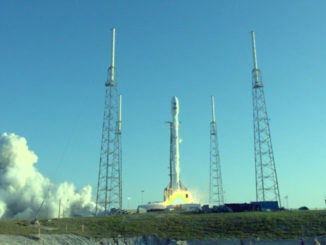Update at 6:30 a.m. EDT (1030 UTC): SpaceX has announced the launch has been delayed until Sunday “to allow more time for vehicle preparations and for weather conditions to improve”. Launch time on Sunday would be at 12:12 p.m. EDT (1612 UTC).

Two more roll-out solar arrays will ride a SpaceX cargo ship to the International Space Station this weekend, continuing a years-long mid-life station upgrade as NASA plans procurement of a final set of new solar wings to fully reinforce the lab’s power supply.
The two solar array wings are rolled up on spools to fit inside the 13-foot (4-meter) diameter of the Dragon spacecraft’s rear cargo bay. Later this month, astronauts Steve Bowen and Woody Hoburg will head outside the space station for two spacewalks to install and assist in the deployment of the two roll-out solar arrays.
NASA has sent four roll-out solar arrays to the space station on SpaceX resupply missions in June 2021 and November 2022.
“We’re very excited to have this third of four sets of arrays, and we’re looking forward to having those installed,” said Dina Contella, NASA’s operations integration manager for the International Space Station.
The new ISS Roll-Out Solar Arrays, or iROSA units, are set for launch on SpaceX’s 28th resupply mission to the space station at 12:12 p.m. EDT (1612 UTC) Sunday. The Cargo Dragon capsule will take off on top of a 215-foot-tall (65-meter) Falcon 9 rocket from Launch Complex 39A at NASA’s Kennedy Space Center in Florida.
The reusable first stage of the Falcon 9 will target a landing on a SpaceX drone ship floating in the Atlantic Ocean.
SpaceX delayed the launch from Saturday “to allow more time for vehicle preparations and for weather conditions to improve.”
But there’s just a 30% chance of favorable weather for launch Sunday, with tropical moisture streaming across Florida predicted to bring rain showers and thunderstorms to the spaceport. The primary weather concerns are cumulus clouds, electric fields that could bring the risk of lightning, and precipitation in the Falcon 9’s flight path.
Assuming a launch Sunday, the Cargo Dragon spacecraft will dock at the Harmony module on the International Space Station at early Tuesday to begin a three-week stay.
The space station’s Canadian-built robotic arm will reach into the Dragon spacecraft’s unpressurized trunk to extract the two roll-out solar arrays and mount them on the station’s football field-long power truss. Then Bowen and Hoburg will head outside the station June 9 and June 15 for spacewalks to install and unroll the new solar arrays.
Meanwhile, astronauts inside the station will unpack cargo stowed inside Dragon’s pressurized compartment. The supplies include food, clothing, experiments, and other hardware for the orbiting research outpost and its seven-person crew.
The station crew members will receive fresh apples, blueberries, grapefruits, oranges, tomatoes, and various cheeses, according to Phil Dempsey, NASA’s transportation integration manager for the space station program.
SpaceX will launch the upcoming space station cargo delivery mission under contract with NASA’s Commercial Resupply Services program. This mission, called CRS-28, will haul 7,284 pounds (3,304 kilograms) of cargo to the station, primarily hardware for upgrades and space station maintenance, along with crew supplies.
It will be the fourth flight of this Cargo Dragon spacecraft, designated C208. SpaceX has three Cargo Dragon capsules in its inventory, and four human-rated Crew Dragon vehicles, with a fifth Crew Dragon in production. SpaceX says it aims to fly each vehicle as many as 15 times, and the existing fleet — along with the new Crew Dragon in manufacturing now — will be sufficient to meet the customer demand for resupply and astronaut flights, primarily to the International Space Station.

The Cargo Dragon spacecraft will deliver equipment to maintain the space station’s urine processing system, which recovers and treats fluid from urine and converts it to drinking water for the space station crew.
The scientific payloads aboard SpaceX’s CRS-28 mission include six CubeSats that will be unpacked by astronauts and transferred through an airlock in the Japanese lab module for release into orbit with a robotic arm.
Five of the CubeSats were developed by university students in Canada. Those missions, sponsored by the Canadian Space Agency, are primarily educational in nature, giving students experience with satellite manufacturing and operations.
The CubeSats carry instruments to monitor the melting of Arctic ice, collect data on space radiation, test a virtual reality camera in space, observe dust storms in Earth’s atmosphere, and study how exposure to the extreme environment of space affects materials similar to the surfaces of the moon and asteroids.
Another CubeSat mission called Moonlighter will serve as a testbed in orbit to test defenses against cyber threats. The spacecraft is about the size of loaf of bread, and once deployed from the space station, it will be part of an annual challenge where cyber security experts will attempt to hack the satellite.
The Moonlighter mission, billed as the world’s first “hacking sandbox” in space, is a joint effort between Aerospace Corp., the Air Force Research Laboratory, the Space Force’s Space Systems Command.
“We wanted to build something new from the ground up to fill gaps in cyber activities in space, where the vehicles to do cyber security testing in orbit have not existed,” said Aaron Myrick, Moonlighter project leader for Aerospace. “When we say it’s a sandbox, Moonlighter is like a playground where we provide the space and the tools for professional hackers to perform cyber exercises and test out new technology. We hope this will lead to more cyber-resilient architectures for future space missions.”
Other research investigations aboard SpaceX’s CRS-28 mission will evaluate plant biology and growth in microgravity and the effects of spaceflight on genetics. A Danish experiment will try to observe and study lightning flashes the bolt out of the tops of thunderstorms.
But the new roll-out solar arrays, or iROSAs, are the top priority of the CRS-28 mission.
The solar arrays were built by Redwire under contract with Boeing, which oversees space station maintenance work for NASA. The pair of solar arrays launching on the CRS-28 cargo mission are the final set NASA has purchased, but Contella said Thursday the agency has “plans in place to try and build a fourth set of arrays” if funding levels permit.
The iROSA arrays are being extended over the station’s eight existing solar array wings, canted at angles to partially cover the older solar panels. Fully deployed, the roll-out solar arrays each stretch 63 feet long and 20 feet wide (19-by-6 meters), about half the length and half the width of the station’s original solar arrays. Despite their smaller size, each of the new arrays can generate about the same amount of electricity as each of the original solar wings.
A mounting bracket plugs the new arrays into the station’s power channels and rotary joints, which keep the solar wings pointed at the sun as the spacecraft races around Earth at more than 17,000 mph.

The International Space Station has eight power channels, each fed with electrical power generated from one solar array wing extending from the station’s truss backbone. The original solar panels launched on four space shuttle missions from 2000 to 2009. As expected, the solar panel efficiency has degraded over time.
NASA wants to reverse that trend to keep the space station productive through the rest of the 2020s until the lab’s anticipated retirement in 2030. A commercial company, Axiom Space, also plans to launch a commercial module to attach to the space station in 2025, which will come with its own power demands.
“This is expected and normal, part of aging, so our ability to augment that power is really important to us, especially as we want to continue research and eventually we’ll also be incorporating the Axiom modules into the ISS, so we need to have as much power as possible,” Contella said.
One of the new arrays set for launch this weekend will cover one of the original space station solar panels that was damaged by an impact from a small piece of space junk or a micrometeoroid last year, Contella said.
The new pair of arrays will be installed on the starboard side of the space station’s power truss, one on the very end of the truss, and another on an inboard section. Once the spacewalking astronauts attach the solar arrays, they will disconnect bolts to allow the arrays to unspool. They are wrapped up for launch using stored energy, meaning they don’t need a deployment mechanism to drive them out to their fully extended length.
With the current set of six iROSA units installed, the ISS power system will be capable of generating 215 kilowatts of electricity, according to NASA.
“Overall the ability to continue to bring our power up to normal levels, and even boosted a little higher for future research, is really critical for the space station,” Contella said.
The solar arrays give the space station one of its most significant mid-life upgrades since NASA and its international partners completed large-scale assembly of the complex in 2011. The six new solar array wings, coupled with 24 new lithium-ion batteries launched to the station on a series of Japanese resupply missions, will help ensure the lab’s power system, can support continued operations through 2030.
At the end of the CRS-28 mission, the reusable Dragon capsule will undock from the station and head for a parachute-assisted splashdown off the coast of Florida in late June with several tons of cargo and research specimens.
Email the author.
Follow Stephen Clark on Twitter: @StephenClark1.



